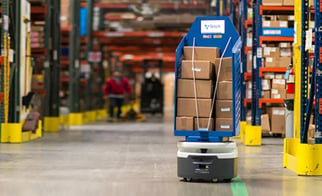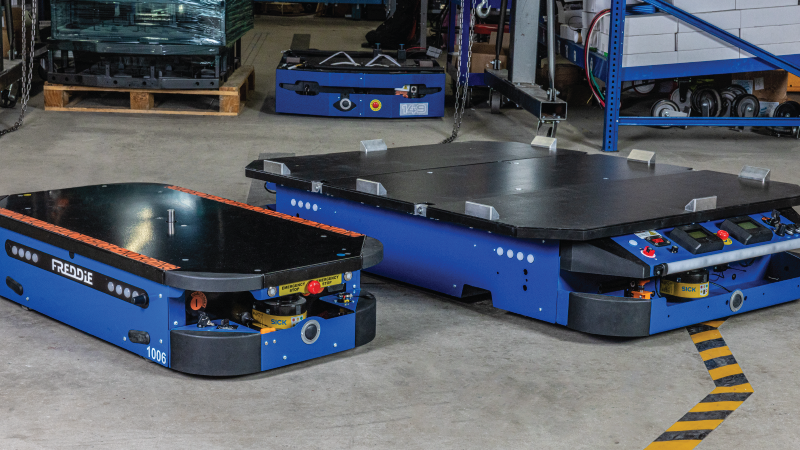It’s not only warehouse managers and distribution center operators who are losing sleep over their productivity and profitability goals.
Every business that receives, holds, and/or ships items needs complete and accurate information about their inventory: what’s in stock and how much, where it is, how fast it’s moving, which items are most popular, when items expire, and about a dozen other data points that impact supply chain efficiency.
To thrive in today’s supply chain landscape, operators have to meet customer and consumer demand for same-day or next-day products—plus choice and control over shipping and delivery methods. That necessitates new levels of inventory visibility accuracy, which in turn requires more advanced inventory data capture and reporting.
Yet as budgets strain under rising real estate, labor, and fuel costs, many facilities remain perpetually understaffed. And outdated inventory tracking methods offer minimal inventory visibility, leading to frequent stockouts that negatively impact customer satisfaction and employee experience.
It’s no surprise that traditional inventory tracking and management methods that rely on human actions yield inaccurate data—but how inaccurate? According to a 2018 study by Auburn University’s RFID Lab and GS1, 69% of orders shipped and received using traditional track and trace methods had data errors. Stated another way, only 31% of customer orders were fulfilled and shipped accurately.
Data inaccuracies aren’t some abstract problem when the data represents concrete, physical inventory. The lack of visibility results in real-life challenges to timely and correct reordering, replenishment, order picking, and shipping. Employees can waste huge chunks of time searching for items that may or may not actually exist in inventory.
The same Auburn study reported on a cohort of brand owners and retailers using GS1’s Electronic Product Code (EPC) enabled radio frequency identification (RFID). Participants using RFID-optimized inventory management and shipment reconciliation were able to achieve 99.9% order accuracy. (And that study was over well before pandemic and supply chain disruptions made inventory management even more critical and complex.)
If you’re relying on traditional methods that passed for effective inventory management a decade ago, it’s time to think about what’s possible with a transition to a RAIN RFID-enabled inventory management system.
Why It’s Time to Let Go of Ineffective Inventory Methods
Too many organizations still use the traditional pen-and-paper method to track and trace inventory, or they’re relying on a hodgepodge of multiple apps. That creates even more complexity and strangles operations with bottlenecks. Both approaches can offer only limited data—not the granular, real-time view needed to plan and act wisely as market conditions and customer demands change.
With traditional tracking, organizations might be fortunate to know what inventory they have; but they have no way to know where it actually is right now, how fast it’s moving out of inventory, or when it might expire.
RAIN RFID-enabled location tracking can change everything by delivering near-100% inventory visibility to warehouse and DC operators.
How? RFID tags attached to products passively transmit real-time location data to networked readers, which update the inventory database in real time. Warehouse and DC workers can also access the database using a mobile device and instantly find out the exact number available, and exactly where they are—right down to the rack, shelf, or storage bin.
Granular location data optimizes picking, replenishment, and reordering. Workers know which items need restocking and can be directed on the fastest pick paths. When physical stock levels match inventory data, out-of-stocks and overstocks drop dramatically.
RFID also facilitates tracking product conditions including temperature, moisture levels, and expiration dates, so perishable goods can be proactively rotated. Internet-of-things (IoT) connected environmental sensors can alert operators to items at risk of spoilage, triggering promotional decisions to sell down inventory before items can expire or spoil.
Virtually every aspect of managing inventory can be streamlined, simplified, and vastly improved by incorporating RAIN RFID track and trace technologies.
Traditional Retail Track & Trace Methods
Many retailers complete a manual inventory count of items in stock to reconcile stock data with the inventory that’s actually in the store. Items are physically counted or barcodes are scanned one by one, and quantities of each item are recorded using an analog tally on paper. After it’s been recorded on paper, it might be manually re-entered into a spreadsheet. The process is time- and labor-intensive, and prone to human error at every step:
Step 1: Map the store, identifying all racks, displays, walls, and shelves where products are placed.
Step 2: Label stockroom boxes and shelves to help ensure all merchandise is accounted for.
Step 3: Account for “odd” products, such as merchandise that’s expected from suppliers, customer returns, items pending fulfillment (such as curbside pickup), and damaged products.
Step 4: Train staff to perform the count properly to minimize errors.
Step 5: Conduct a time-consuming inventory count—and cross your fingers that no items are missed and calculations are performed correctly.
When a retailer completes this kind of inventory count, they may discover whether or not in-store stock aligns with what they expected...and that’s about all they learn.
How RFID Track & Trace Revolutionizes Inventory Accuracy & Visibility
Fortunately, RFID has been in use for decades across a broad range of industries for asset tracking and inventory management. As a result, over the past decade—and especially over the past few years—leading retailers have begun mandating RFID source-tagging by suppliers.
Walmart’s RFID mandate gets a lot of attention, but it’s far from the only retailer that sees the operational value of comprehensive, accurate inventory. Target, Macy’s, Nordstrom, Costco, Lowe’s, Best Buy, and many others have been using RFID over years and even decades. Why so many? Because retailers are experiencing bottom-line benefits from advantages that include:
- Improved employee productivity and retention
- Greater insights into inventory mix and stock levels
- More complete shipments fulfilled
- Reduced demand for manual labor and associated costs
- Enhanced asset security and reductions in shrinkage
- Better compliance with regulatory and vendor/partner standards
- Improved retail customer experience
- Increased ability to sell down inventory closer to zero
- Comprehensive awareness of the journey from raw material to consumer product
- Ability to meet increasing consumer demand for product transparency
In fact, retailers now have the opportunity to test and experience for themselves what’s possible using RAIN RFID infrastructure in action at Barcoding’s Retail Experience Center.
This retailer push creates new opportunities for suppliers to leverage RFID for their own benefit, as well, since RFID gives suppliers real-time inventory visibility across their entire supply chain.
Products can be tracked from manufacturing to warehouses, third-party logistics providers’ (3PL) locations, and in transit. Inventory levels can be optimized at each unique point across the supply chain, and RFID-powered automation enables dock-door shipment verification to prevent mis-ships. Goods no longer sit unchecked in trailers or docks. Expediting fees, detention charges, and compliance penalties drop.
Along with granular inventory details, RFID users can also track assets like tools and equipment, helping to reduce theft and loss, track usage, manage maintenance, and more.
And that’s not even beginning to touch on RAIN RFID’s many applications in grocery and food supply chains.
How Does RAIN RFID Work?
RFID systems use short-range radio waves to send data from RFID-tagged products or assets to devices that capture the information and transmit it to a database—establishing a single source of automatically updated inventory and asset data that’s accessible by multiple users. This eliminates the risks associated with multiple copies or versions of spreadsheets and the inaccuracies they generate. Here’s how it works in general terms:
RFID tags are affixed to each asset. RFID tags can store a wealth of information, such as manufacture date, handling instructions, condition, temperature, serial number, location, movements, storage requirements, how long a product has been in the warehouse, how many times it’s been accessed, and its status (such as “awaiting pickup” or “held for customer”).
RFID tag type depends on the use case. Active RFID tags are battery powered and have a read range of up to around 50 feet. Passive RFID tags are powered by the reader or antenna and have a lower signal range than active tags. Semi-passive tags are a hybrid of these two, having both internal batteries and an antenna and RFID chip. In most retail use cases, passive RAIN RFID is used.
RFID readers emit radio waves to get signals from the RFID tag. (In more complex systems, connect wirelessly to a separate antenna in order to get the information). Readers can be handheld or mounted in various configurations, or integrated into other equipment. The readers can access information in real time and relay the data to a software solution where it can be stored and referenced as needed.
RAIN RFID’s Major Benefits to Retail Suppliers
In addition to the abundance of information they make available in an instant, RFID systems offer unique capabilities that make tasks faster, easier, and even safer for workers in the warehouse or DC—while delivering accurate, up-to-the-minute inventory data:
- Workers don’t actually have to be in the line of sight of the items they’re scanning
- Tags can be read from up to 40 feet away
- A device can read up to 200 RFID tags simultaneously
That means an employee can scan an entire room or area filled with pallets in just seconds — indoors or out, in a wide range of temperature and humidity conditions. Pallets or items on them aren’t skipped or missed due to human error, and no special maneuvering is needed to access the data.
What Can You Do With RFID? Start Here
Once you have a clear view of the quantity of data you can access, the inventory accuracy that automation makes possible, and the operational areas where greater visibility and awareness will improve your decision-making, there's virtually no limit to what you can improve. Here are a few strong starting points:
Track anything from raw materials and components to finished products. RFID tags make it possible to track parts, components, and even packaging supplies from vendor partners as they move through every point in your supply chain. Every step—from supplier to satellite sites, to 3PLs to gate in/gate out, to the elevator lift, to shipping containers—is a point at which the tag and its information is scanned, and an inventory management solution updates the data record.
Optimize shipping. Tagging and scanning shipments enables any designated user of your solution to see exactly what has been loaded or removed from a truck, so your team can get it where it needs to be, when it needs to be there. This minimizes the risk of expedited carrier fees, and of product deterioration from sitting too long on a trailer in the dock.
Reduce misplaced assets and theft. Even organizations in industries like construction see large annual losses to misplaced, lost, or stolen items—whether consumable supplies or high-value tools and equipment. Tagging items enables asset tracking, including exact locations at all times.
Optimize warehouse layouts. Implementing an RFID system can help reveal which products move fastest, which are stagnant, whether seasonality is a consideration, and other data trends that can inform a reconfigured layout so that workers can quickly access the most in-demand products for greater efficiency and productivity.
Ensure product safety. RFID tags can be used to prevent expired or compromised products from becoming accessible for shipment or sale. Sensors can detect temperature or humidity issues that can lead to spoilage.
It’s not an overstatement to say that RFID’s tracking and tracing capabilities—and the improvements you can see if you implement the technology with the right guidance—could determine whether or not you survive the next major global supply chain challenge.
Lack of visibility into your own inventory only compounds the shipping and fulfillment roadblocks standing in your way as you try to get goods where they need to be, when they need to be there. Not only does RFID speed inventory counts and improve accuracy, but it can help provide you with a wealth of information—about operational processes, physical facilities, vendor performance, customer demand, and much more. And that’s all information that can improve your enterprise awareness and decision-making capabilities, not to mention the performance of your supply chain.
If retailers are among your customers, it’s time to make the most of your retailer-mandated investments in RFID technology. Learn more about what’s possible, and how to get there by downloading our free guide.







